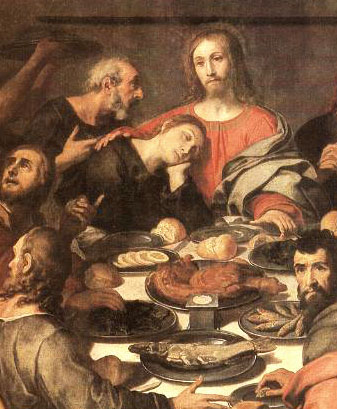|
Discrepancies Within The Bible Any time someone points to the Christian Bible to justify their moral standards (or, more often, their bigotry) their opposition will usually shrug them off by pointing out the various logical inconsistencies and logistical improbabilities contained in the text of the Bible. How likely is it, they argue, that the Earth was really created in seven days? Or, if God only created two original people -- Adam and Eve -- and left it up to them and their descendents to populate the Earth, doesn’t that mean that God created people to commit incest? Is incest then a "Bible value"? So why pick on homosexuals? And so on.
Any time someone points to the Christian Bible to justify their moral standards (or, more often, their bigotry) their opposition will usually shrug them off by pointing out the various logical inconsistencies and logistical improbabilities contained in the text of the Bible. How likely is it, they argue, that the Earth was really created in seven days? Or, if God only created two original people -- Adam and Eve -- and left it up to them and their descendents to populate the Earth, doesn’t that mean that God created people to commit incest? Is incest then a "Bible value"? So why pick on homosexuals? And so on.
Because the Bible was constructed by different authors over at least 3500 years, it is rife with discrepancies of both logic and detail. Not only are there things within it that don't make sense from modern scientific and materialist perspectives, but there are also discrepancies between various manuscript copies of the Bible (300,000 within the New Testament alone). Even within any given modern text of the Bible (such as the King James Version, the NIV, the English Standard Version etc.) there are scores of conflicting facts and moral guidelines. Everything from descriptions of God's nature and desire for the life of Christ to moral guidelines and prohibitions -- all are riddled with conflicting claims and assertions. Certainly this fact does not invalidate the Bible as a spiritual text. Inaccuracies or conflicting accounts do not invalidate the gems of historic and spiritual truth contained therein -- we need not throw out the baby with the bath water. However, such discrepancies indicate that we would be equally foolish to accept blindly each word or passage of the Bible as an absolute truth, the uncontestable word of God, unless of course we were trying to claim God has a sick sense of humor and is trying to lead us astray by confusing us.
Far more realistic than either of these opportunistic approaches is to acknowledge the types of errors which occur in the Bible and to understand the underlying source of the error. This being done, those hermeneutic somersaults becomes similar to the work of a police investigator who collects the statements of various witnesses to an event (or series of events) and then compares them for shared details and observations. Nowhere is this principle more blatantly obvious than in the New Testament, which is is clearly a collection of different people's telling of the story of Christ and/or the Apostles. For example, we have the Gospels of Matthew, Mark, Luke, and John. There are the Acts of the Apostles, and there are letters written by various individuals. Thus, regarding the coming birth of Jesus, the Gospel of Matthew has the angel announcing the birth (and explaining matters) to Joseph (Matthew 1:20), while Luke has the angel visiting Mary (Luke 1:28). We as readers should not assume that one version of the story is wrong while the other is right, nor should we assume that both are totally false. What is more likely, in such situations, is that each story contains some measure of truth (or at least, some measure of the original story), and that each story represents a different oral tradition of the life of Jesus. That is, someone told one version of the tale, as he remembered it, and someone else told another version, and then these were passed down through other people, who may have added or deleted something as they passed the tale along. These accounts were often not written down until decades after the original events had transpired. And just as often, they were not written by the individual whose names they bear, but by one or more disciples, themselves working from notes and remembered oral lore. In some cases it may be that the story written down was only transcribed after it had been told and retold and retold, until the original details had grown fuzzy or had been slightly embellished for dramatic purposes. (Many have undertaken to draw up an account of the things that have been fulfilled among us, just as they were handed down to us by those who from the first were eyewitnesses and servants of the word. -- (Luke 1:1-3)) In other cases, the written account may be trying to conflate more than one version of the tale. Thus there is repetition and even conflicting claims within the narrative. As a result, for example, we have grossly varying accounts of the birth and early years of Jesus. Matthew tells of wise men (the magi) coming from afar to find the baby Jesus lying in a manger and give him gifts. Herod the King is having babies slaughtered left and right in order to eliminate the prophesied King of the Jews who he thinks will dethrone him. Joseph dreams of the danger and whisks his little family away to Egypt. Eventually Herod dies and the Holy Family can safely return to Israel and settle in at Nazareth. In Luke's version of the tale, shepherds pay him homage and then, 8 days later, he is presented in the Temple (where he is prophesied over by saints), after which they return to Nazareth. There are no magi, not even later on. What's more, in Luke's version there is no slaughtering of innocent babes (historians agree with Luke).
But now in Christ Jesus you who once were far away have been brought near through the blood of Christ. For he himself is our peace, who has made the two one and has destroyed the barrier, the dividing wall of hostility, by abolishing in his flesh the law with its commandments and regulations. His purpose was to create in himself one new man out of the two, thus making peace...Clearly one is left to wonder: which way is it? Was Jesus here to initiate his followers into a new way of life in which the old commandments no longer applied, or simply to reinforce and honor them along with all the old purity rules (see Leviticus)? Some have suggested that Jesus' ministry (and the man himself) may have gone through some kind of spiritual and philosophical transformation, leaving remnants of both earlier and later phases in these writings. Or it might be that one or both of the writers didn't get their facts straight. In any case, the fact remains that such conflicts make it difficult for Christians (and their critics) to understand what exactly Christianity was orignally all about and to compare this to current interpretations coming from varied Christian denominations -- including, of course, know-it-all televangelists.
Additionally, the more repressive branches of Christianity have taken these same Jewish purity laws (now known as The Word of God or "the Bible tells us...") and blown them all out of proportion. That is, simple classifications of impurity are now damnable offenses that will corrupt your soul and send you down a one way road to hell. The irony is, it is still being debated (outside Fundamentalist circles at least) as to whether Jesus truly wanted non-Jews to follow these purity rules. Clearly they have been excused from the ban on pork eating and male circumcision (which became an American fad only in the 19th century -- see Masturbation.)
This is not the only point of confusion for earnest Christians seeking guidance from the Bible. In fact, a whole slew of contradictions exist in the Bible which make it rather difficult to know what "Christian behavior" really means. Compare the following:
"...thou shalt give life for life, Eye for eye, tooth for tooth, hand for hand, foot for foot. burning for burning, wound for wound, stripe for stripe." and
When a man makes a vow to the LORD or takes an oath to obligate himself by a pledge, he must not break his word but must do everything he said. The last passage, attributed to Jesus, would imply that Christians should not assume that what the Old Testament teaches holds still holds true. Various other Old Testament rules and advice are also, elsewhere, specifically invalidated by Jesus (Mark 7:18-19 on food restrictions, and Galatians 6:15 on circumcision). Even divorce, which was allowed under Mosaic Law (Deuteronomy 24:1-5) is expressly prohibited by Jesus:
Some Pharisees came and tested him by asking, "Is it lawful for a man to divorce his wife?" "What did Moses command you?" he replied. They said, "Moses permitted a man to write a certificate of divorce and send her away." "It was because your hearts were hard that Moses wrote you this law," Jesus replied. "But at the beginning of creation God 'made them male and female.' 'For this reason a man will leave his father and mother and be united to his wife, and the two will become one flesh.' So they are no longer two, but one. Therefore what God has joined together, let man not separate." When they were in the house again, the disciples asked Jesus about this. He answered, "Anyone who divorces his wife and marries another woman commits adultery against her. And if she divorces her husband and marries another man, she commits adultery." All this emphasizes the point that when it comes to "what the Bible says", what it says is rarely clear cut. On most issues of importance, one can find at least one Biblical passage to support each side of the argument. Which is why, for centuries, the Catholic Church maintained such a jealous hold over the interpretation of doctrines, asserting that "the truth" could not simply be found in the Bible, but must be handed down from on high to lay persons via the priest, who supposedly had it handed down to him via a long lineage dating back to the Apostles. Naturally such assertions do little to explain why "the truth" would then contain later dogmas that were largely the invention of the Catholic Church (for example: purgatory, the buying of indulgences, etc.).
The Nature of God
|
 But as much as Christian Fundamentalists would have us interpret every word in the Bible literally (thus rejecting the entire
But as much as Christian Fundamentalists would have us interpret every word in the Bible literally (thus rejecting the entire  However, the discrepancies in the story of Jesus are not to be found only in the narration of his early years. In fact, some of the conflicts present in the Gospels and other accounts make it difficult to understand what exactly Jesus' mission and philsophy was:
However, the discrepancies in the story of Jesus are not to be found only in the narration of his early years. In fact, some of the conflicts present in the Gospels and other accounts make it difficult to understand what exactly Jesus' mission and philsophy was:
 While the passages quoted above are but two amongst scores of discrepancies to be found in the New Testament, they actually raise a very important point: what is Christianity's relationship to the Old Testament -- or more accurately, to the doctrines of Judaism, from whose holy Tanach is derived the Christian Old Testament? While this might seem like a trivial, scholarly matter to some, it is in fact Christianity's adherence to the ancient Jewish purity rules that cause it to reject all human sexual expression besides the blandest missionary coitus. Fellatio, cunnilingus, anal sex, homosexual explorations, sex on the rag -- all are taboo thanks to ancient Jewish purity laws.
While the passages quoted above are but two amongst scores of discrepancies to be found in the New Testament, they actually raise a very important point: what is Christianity's relationship to the Old Testament -- or more accurately, to the doctrines of Judaism, from whose holy Tanach is derived the Christian Old Testament? While this might seem like a trivial, scholarly matter to some, it is in fact Christianity's adherence to the ancient Jewish purity rules that cause it to reject all human sexual expression besides the blandest missionary coitus. Fellatio, cunnilingus, anal sex, homosexual explorations, sex on the rag -- all are taboo thanks to ancient Jewish purity laws.
